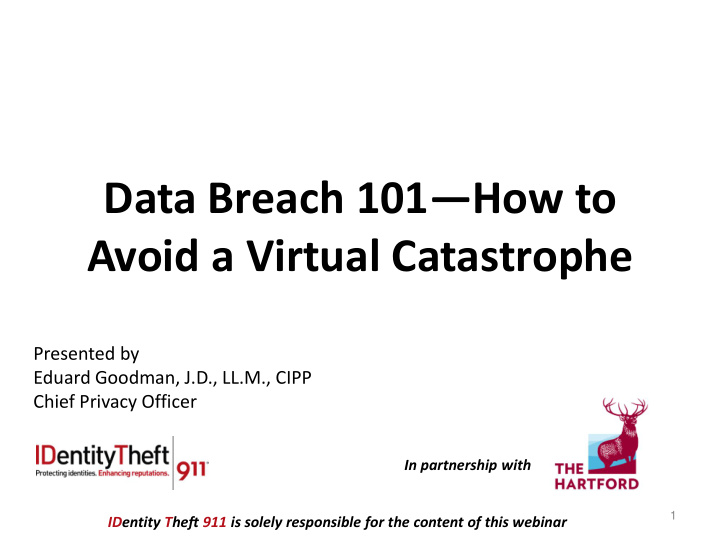



Data Breach 101 — How to Avoid a Virtual Catastrophe Presented by Eduard Goodman, J.D., LL.M., CIPP Chief Privacy Officer In partnership with 1 IDentity Theft 911 is solely responsible for the content of this webinar
Today’s objectives: Understand what a data breach is from a regulatory perspective Explore how a data breach can occur Recognize your privacy and data risk exposures and liabilities Identify some basic ways to assess, reduce and manage the risks ID entity T heft 911 is solely responsible for the content of this webinar 2
What is a data breach? Under state breach notification laws, businesses must notify customers, patients and/or employees if there has been a breach that exposes their Personally Identifiable Information (PII). 3
What is a data breach? Personally Identifiable Information (PII) includes … Social Security Numbers Driver’s License/State Issued ID Numbers Payment Card Numbers Financial Account Numbers/Routing Info Health Information Biometric Data Secondary Identifiers (eg : mother’s maiden name, date of birth, etc.) 4
What is a data breach? Depending upon the applicable state law, PII includes various forms of information/data. Examples include … Digital and hard copy data (or paper files); Encrypted/unencrypted data; Data lost by the business; and Data lost by a third party vendor 5
What is a data breach? Notice is required in 50 jurisdictions in the United States (51 laws including Federal HIPAA/HITECH notice requirements) • 46 states; • District of Columbia; • Puerto Rico; • U.S. Virgin Islands; and • Guam 6
What is a data breach? The only states currently without a notification law are: Alabama; Kentucky; New Mexico; and South Dakota 7
Common ways a data breach can happen Computer hacking Stolen or lost laptop or computer disks Stolen or lost paper documents / files Stolen credit card information Employee error or oversight 8
What a data breach could mean for your business Loss of customer and/or employee trust Tarnished reputation Lost revenue 9
State Data Breach Notification Laws In addition to notification requirements, most states typically have (broad) language around the treatment, security and/or disposal of personal information wrapped up into their data breach notification regulations 10
Self Regulatory Security Requirements Payment Card Industry Data Security Standards (PCI-DSS) Set of security requirements and standards promulgated by the payment card issuers (Visa, MasterCard, Discover, American Express, and JCB) regarding the storage and security of payment card-related data. 11
Immediate To-Do List (Assess Exposure) Consider the your business’ “data footprint” What type of data is collected? From whom? From where? For what purpose? Who can access the data? Where is data stored, processed, etc? 12
Immediate To-Do List Assess and Cover Risk Complete high level “data” audit to determine • Type of personal information you retain • What states do your customers/employees live in Complete a Security audit to determine weaknesses Determine if you have adequate insurance coverage for your risk (eg: limits) 13
Immediate To-Do List Help to reduce your risk or exposure Don’t collect data on customers or employees unless you need it • Why are you collecting Social Security Numbers? Get rid of any data you collect as soon as you no longer need it. It’s toxic – it’s not an asset; it’s a liability. Encrypt any private personal data 14
Immediate To-Do List Documentation / Programs Written Information Security Program Breach Response Plan Business Continuity Plan Data/Document Retention and Destruction Plan Data Security and Privacy Awareness Program 15
Immediate To-Do List Documentation / Programs Develop a “privacy framework” for your business that fits from a: philosophical standpoint; business standpoint; and an operational standpoint 16
For more data breach- related information … Visit www.aahainsurance.org/ to get information on how to protect your practice with data breach insurance coverage and services. You will also receive a follow-up email with additional resources. 17
Thank you! Eduard Goodman, J.D., LL.M., CIPP Chief Privacy Officer Presented by Scottsdale, Arizona Edi Goodman 480.355.4940 direct In partnership with EGoodman@IDT911.com 18
Recommend
More recommend